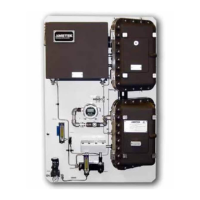Maintenance and Troubleshooting | 6-9
Setup (tab)
Gas Calibration<<Flow
Control>>
Setup (tab)Cell/Misc
“P/N” refers to Part Number.
To clean and replace parts in the Measuring Cell (see Figures 6-1 and 6-2):
Hazardous Locations
Before proceeding, test the area around the analyzer for explosive
gases and proceed only when the area is found to be safe.
Do not remove the cover of the Explosion-Proof Digital
Communications Port on the front of the Lower Enclosure, do not
connect a serial cable to the Communications Port, do not open the
Upper/Lower Enclosures, and do not power up/down the analyzer or
computer if there is an explosive gas atmosphere present.
1. Connect a serial cable between the computer and the analyzer’s
Communications Port. Using the Configurator Software, change the
Flow Control setting to ‘2’ (zero) . Click OK then Apply. Do not save
the changes to EEPROM.
2. Analyzer with Heated Cells:
Remove the Insulating Jacket or open the Oven door to allow the Cell
to cool down enough to work on it.
3. If the analyzer uses measured Pressure Compensation (optional),
change the pressure compensation to fixed mode so that a “f: Sample
gas pressure too low” alarm does not occur. To do this, view the Cell/
Misc Parameters dialog box and enter a value in the Default Cell
Pres (pressure compensation) field that is the same as, or approxi-
mately, the Measuring Cell pressure. Refer to “Cell/Miscellaneous
(Compensation) Parameters” in Chapter 4.
Close the isolation valve on the Sample Line or Sample Probe (if used).
Backpurge the analyzer sample system with Zero gas for 2–3 minutes.
4. Change the Flow Control setting to ‘1’ (shut-in/off) . Click OK then
Apply.
Bleed down the sample system to atmospheric pressure (check gauge).
Close the valve on the Vent Line side (or cap the Vent outlet).
If the sample system does not have an isolation valve, Zero gas may
continue to flow. Shut off the Zero gas.
NOTE
!
WARNING
NOTE

